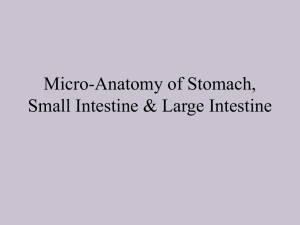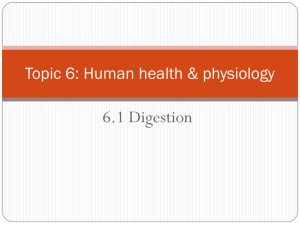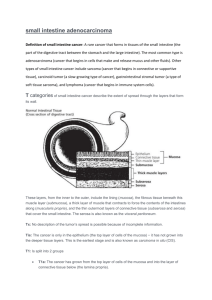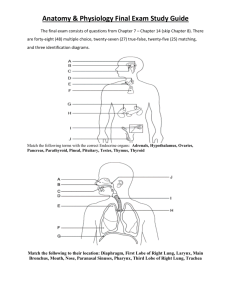characterization of normal feline small intestine and associated
advertisement
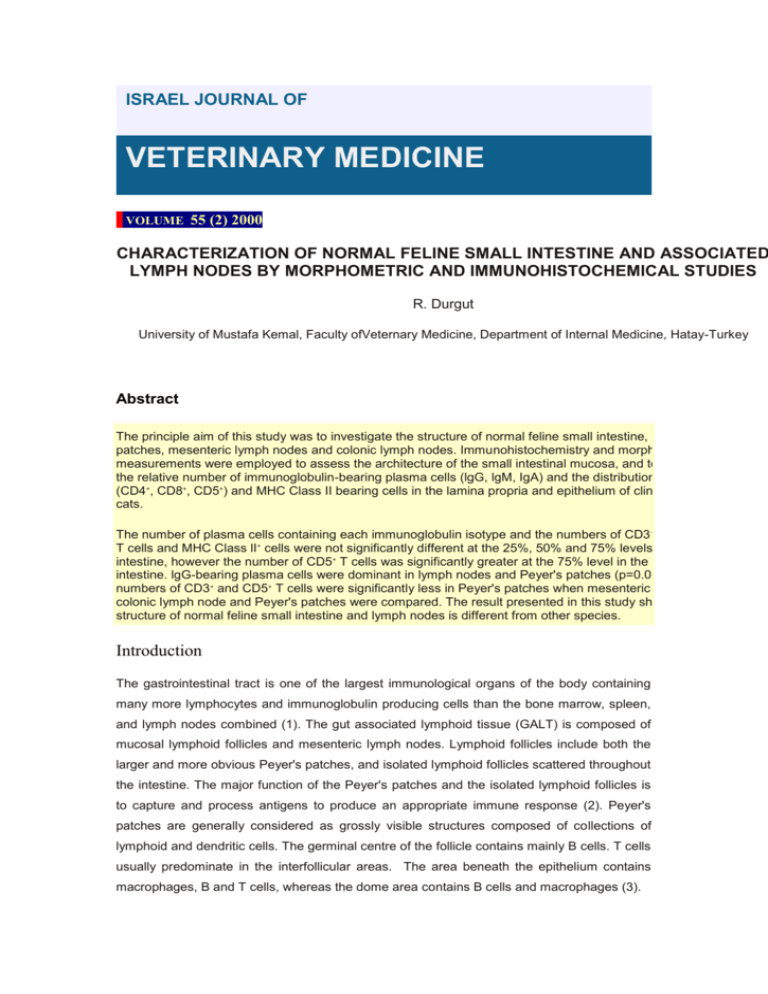
ISRAEL JOURNAL OF VETERINARY MEDICINE VOLUME 55 (2) 2000 CHARACTERIZATION OF NORMAL FELINE SMALL INTESTINE AND ASSOCIATED LYMPH NODES BY MORPHOMETRIC AND IMMUNOHISTOCHEMICAL STUDIES R. Durgut University of Mustafa Kemal, Faculty ofVeternary Medicine, Department of Internal Medicine, Hatay-Turkey Abstract The principle aim of this study was to investigate the structure of normal feline small intestine, Peyer's patches, mesenteric lymph nodes and colonic lymph nodes. Immunohistochemistry and morphometric measurements were employed to assess the architecture of the small intestinal mucosa, and to determine the relative number of immunoglobulin-bearing plasma cells (lgG, lgM, IgA) and the distribution of T cells (CD4+, CD8+, CD5+) and MHC Class II bearing cells in the lamina propria and epithelium of clinically healthy cats. The number of plasma cells containing each immunoglobulin isotype and the numbers of CD3 +, CD4+, CD8+ T cells and MHC Class lI+ cells were not significantly different at the 25%, 50% and 75% levels of the intestine, however the number of CD5+ T cells was significantly greater at the 75% level in the small intestine. lgG-bearing plasma cells were dominant in lymph nodes and Peyer's patches (p=0.01). The numbers of CD3+ and CD5+ T cells were significantly less in Peyer's patches when mesenteric lymph node, colonic lymph node and Peyer's patches were compared. The result presented in this study show that the structure of normal feline small intestine and lymph nodes is different from other species. Introduction The gastrointestinal tract is one of the largest immunological organs of the body containing many more lymphocytes and immunoglobulin producing cells than the bone marrow, spleen, and lymph nodes combined (1). The gut associated lymphoid tissue (GALT) is composed of mucosal lymphoid follicles and mesenteric lymph nodes. Lymphoid follicles include both the larger and more obvious Peyer's patches, and isolated lymphoid follicles scattered throughout the intestine. The major function of the Peyer's patches and the isolated lymphoid follicles is to capture and process antigens to produce an appropriate immune response (2). Peyer's patches are generally considered as grossly visible structures composed of collections of lymphoid and dendritic cells. The germinal centre of the follicle contains mainly B cells. T cells usually predominate in the interfollicular areas. The area beneath the epithelium contains macrophages, B and T cells, whereas the dome area contains B cells and macrophages (3). The principle aim of this study was to investigate the structure of normal feline small intestine, Peyer's patches, mesenteric lymph nodes and colonic lymph nodes. Materials and Methods Animals: All animals were specific pathogen-free derived cats, maintained on a standard commercial diet (Wiscas, Master Foods, Austria G.m.b.H, A-2460, Bruck/Leitha) and housed under normal conditions (18-200C, moisture 60%-75% with each cat allocated to 2 m 2) in an animal house in this experiment. In this study cats were allocated to one of two groups. This group consisted of five female and three male domestic shorted-haired cats (DSH), between 1 and 2 years old. Morphometric Studies: Morphometric characteristics of the small intestine were assessed at 25 %, 50 %, and 75 % of the full length, roughly corresponding to the duodenum, jejunum and ileum respectively. Small intestinal biopsies, mesenteric lymph node and colonic lymph node collected post mortem were formalin fixed, paraffin wax embedded and then processed by routine methods. The intestine was sectioned longitudinally. Sections were cut at 4 µm and stained with haematoxylin and eosin (H&E). Villus height, villus width and crypt depth were measured and the number of intraepithelial lymphocytes (IEL) were counted and expressed as numbers of IEL/100 enterocytes using video assisted microscopy (VIDS, Image Processing Systems, Synoptic Ltd, England). Immunostaining Techniques: Characterization of small intestinal lymphoid cells, the mesenteric lymph node and colonic lymph node was performed by immunohistochemistry . The numbers of IgA, lgG, and lgM - producing plasma cells, CD3+, CD4+, CD5+, CD8+ and MHC Class II + cells were examined in the small intestine (25%, 50% and 75% levels), Peyer's patches and mesenteric lymph node. Immunohistochemistry tests were carried out according to the procedure described by Ackley and colleagues (4), Baldwin et al. (5), Klotz et al. (6, 7), Rosekrans et al. (8), and Durgut, (9). The cells were counted by VIDS as cells/mm 2 of tissue mononuclear cells in a particular area of tissue. Statistical Analysis: Microsoft Excel for Windows 95 version 7, was used to compute the Student's t-test and Minitab for Windows 3.1 was used to determine analysis of variance, and the Kruskal-Wallis test. Analysis of variance was used to determine whether there was a significant difference between the 25%, 50% and 75% levels of the small intestine with respect to morphometric measurements, the number of immunoglobulin-bearing plasma cells and the distribution of the numbers of T cell subsets. Results The morphometric characteristics of normal small intestine at the 25%, 50% and 75% levels were similar for all cats. There were no significant differences in villus height, villus width, crypt depth or intra-epithelial lymphocyte (IEL) numbers at different positions along the small intestine (Table 1). The numbers of plasma cells containing each immunoglobulin isotype was not significantly different at the 25%, 50% and 75% levels of the feline small intestine. There was no difference between the number of IgA and lgM- bearing plasma cells in lymph nodes and Peyer's patches, and lgG-bearing plasma cells were dominant in lymph nodes and Peyer's patches (p=0.01) (Table 2). The numbers of CD3+, CD4+, CD8+ T cells and MHC Class II+ cells were not significantly different at all three levels of small intestine; however the number of CD5 + T cells was significantly greater at the 75% level (p<0.001). The number of CD3 + and CD5+ T cells were significantly less in Peyer's patches when the mesenteric lymph node, colonic lymph node and Peyer's patches were compared, but the number of CD4 + and CD8+ T cells and MHC Class II+ cells was similar (p<0.001). A greater number of CD4+ and CD8+ T cells were found at all levels of the small intestine compared with the number ofCD5 + and CD3+ T cells (Table 3). Table 1: Morphometric characteristic of normal feline small intestine. Levels of intestine Villus height (mm) Villus width(mm) Crypt depth(mm) IEL/100 Enterocyts 25% 422+/-210 91+/-41 184+/-44 23+/-3 50% 481+/-188 91+/-42 194+/-44 25+/-3 75% 436+/-188 98+/-34 178+/-54 22+/-3 Table 2: Immunoglobulin-bearing plasma cells in the lamina propria of normal feline small intestine and associated lymphoid tissues. Levels of intestine IgA IgG IgM 25% 37+/-2 23+/-4 25+/-4 50% 40+/-4 27+/-6 25+/-5 75% 39+/-4 28+/-6 26+/-6 MLN 17+/-2 25+/-4 14+/-3 CLN 18+/-4 31+/-4 17+/-4 PP 18+/-5 30+/-3 16+/-3 Cells were counted in 0.05 mm2 and the mean +/- s.d of cells expressing immunoglobulin of each class are presented; MLN- mesenteric lymph node; CLN- Clonic lymph node; P.PPayer's patches Table 3: Characterization of T cell subsets in the normal feline small intestine and associated lymphoid tissues Levels of intestine CD3 CD4 CD5 CD8 MHC class II 25% 23+/-5 23+/-4 18+/-5 25+/-10 32+/10 50% 23+/-7 23+/-6 22+/-5 20+/-7 26+/8 75% 23+/-8 20+/-6 32+/-3 22+/-5 22+/6 MLN 55+/-11 23+/-4 62+/-4 30+/-4 25+/3 CLN 52+/-11 23+/-3 55+/-7 25+/-6 23+/4 PP 38+/-9 21+/-3 42+/-7 23+/-5 27+/4 Cells were counted in 0.05 mm2 and the mean +/- s.d of cells expressing immunoglobulin of each class are presented: MLN- Mesenteric lymph node, CLN-Clonic lymph node, PP-Payer's patches. Discussion The results of the study showed that there were no significant quantitative differences between the various levels of the small intestine of the cat, whereas all these parameters differ throughout the small intestine of normal dogs (10). The morphology of the small intestinal villi has already been described in the cat by Henry and AI-Bagdadi (11) and in other domestic animals (12). The mean villus height recorded in the current study was generally lower than that previously reported for the cat, but greater than the height of villi from the duodenum and upper jejunum in man (13). This study revealed that the villi of the cat were much longer than those in the horse and cow, and shorter than in the goat, pig and dog (12). The morphometric measurements which were made within normal cats showed no statistical differences in terms of villus width, crypt depth and IEL count at any level of intestine. By contrast, there was a statistically significant difference in villus height. Similar results have been reported for clinically normal, young and elderly people (14). The IELs observed in the cat intestine were generally located in the basal region of the mucosal epithelium, below the level of the epithelial cell nuclei. Also the IEL counts at the different levels of the feline small intestine were similar. The number of IELs in the cat reported here was more than in the mouse (15) and rat (16), but less than reported for the dog (10), pig (17) and man (18). Roth et al. (19) have reported that plasma cells are the predominant mononuclear cells in the feline small intestine. In the present study, the number and proportions of plasma cells containing each immunoglobulin isotype (IgA, lgG, lgM) remained fairly constant throughout the different levels of the small intestine. The ratio of IgA: lgG: lgM bearing plasma cells was no different (1:1:1) when counting method was employed. By contrast, the ratio oflgA:lgG:lgM bearing plasma cells was reported as 2:1:1 in the mucosa of the canine small intestine (10, 20). The percentages of CD4+ and CD8+ T lymphocytes in the peripheral blood and other lymphoid tissues of clinically normal adult cats have been previously reported (21), but these cells have not been enumerated in the gut. The CD4+ and CD8+ T cells were distributed unequally between the epithelium and lamina propria. Most CD4+ T cells were found within the villus core, whereas CD8+ T cells were concentrated around the epithelial basement membrane and outermost lamina propria. A similar distribution has been reported in pig small intestine, where the majority of CD8+ T cells were concentrated around the epithelial basement membrane (22). In contrast to the results presented here which show small numbers of CD4 + IEL's in the cat intestinal epithelium, it has been previously reported that very few CD4+ T cells were found in the epithelium of pig (22). In gut the total numbers of CD4+ and CD8+ T cells greatly exceeded the number of cells which stained positively for CD5+ In contrast, in both mesenteric lymph node and colonic lymph node the combined numbers of CD4+ and CD8+ cells roughly equalled the number of CD5+ cells. In other species it has been shown that CD5+ is expressed on all mature T cells and on a subset of mature B cells (22). The discordant result with lamina propria cells is therefore perhaps surprising. It is possible that it may reflect an increase in the number of CD5 + B cells in the gut lamina propria. The immunohistochemical studies demonstrated that MHC Class II+ mononuclear cells were more numerous within the epithelium of the crypt than that of the villus. This distribution was opposite to that recorded for the pig (21). There was no expression by enterocytes as determined by immunohistochemistry. MHC Class II+ cells observed in the feline small intestine may be macrophages, dendritic cells, B cells or other cell types located in the gut. References 1. Brandtzaeg, P.: Structure, Synthesis and external transfer of mucosal immunoglobulins. Annu. Immunol., 26:1101-1114, 1974. 2. Keren, D.F.: Gastrointestinal immune system and its disorders. In: Goidmann, H, Appelman, HD, Kaufinan N. (eds): Gastrointestinal Pathology, W.B. Saunders, pp. 247-285, 1990. 3. Lebman, D.A., Griffin, P.M. and Cebra, J.J.: Relationship between expression of IgA by Peyer's patches cells and functional IgA memory cells. J. Exp. Med., 166:1404-1418, 1987. 4. Ackley, C.D., Hoover, E.A. and Cooper, M.D.: Identification of feline CD4 homologue of the CD4 antigen. Tissue Antigens, 35:92-98, 1990. 5. Baldwin, C.I. and Denham, D.A: Isolation and characterization of three subpopulations of IgG in the common cat (Felis catus). Immunology, 81:155-160, 1994. 6. Klotz, F.W., Gathings, W.E. and Cooper, M.D.: Development and distrubition of B cell lineage in the domestic cat. J.Immunol., 134:95-100, 1985. 7. Klotz, F.W. and Cooper, M.D.: A feline thymocyte antigen defined by monoclonal antibody (FTZ) identifies a subpopulation of non-helper cells capable of specific cytotoxicity. J.Immunol., 136:95-100, 1986. 8. Rosekrans, P.M.C., Meijer, C.J.L.M. and Van der Wal, A.M.: Immunoglobulin containing cells in IBD of the colon: A morphometric and immunohistochemical study. Gut, 21:941-947, 1980. 9. Durgut, R.: A study of the pathogenesis of inflammatory bowel disease in the cat. MSc Thesis. University of Bristol, England, 1996. 10. Hart, I.R. and Kidder, D.E.: The quantative assessment of normal canine small intestinal mucosa. Res. Vet. Sci., 25:157-162, 1978. 11. Henry, R.B. and AI-Bagdadi, F.K.: Duodenal microanatomy of the domestic cat. Histol. Histopathol., 1:355-362, 1986. 12. Titkemeyer, C.W. and Calhoun, M.L.: A comparative study of the small intestines of of domestic animals. Am. J. Vet. Res., 16:1-10, 1955. 13. Doniach, 1. and Shinner, M.: Villi measurements from the duodenum to jejunum in man. Gastroenterology, 33:71, 1957. 14. Arranz, E., Mahony, S.O., Barton, J.R and Ferguson, A.: Immunosenescence and mucosal immunity: significant effects of old age on secretory IgA concentrations and IEL counts. Gut, 33:882-886, 1992. 15. MacDonald, T.T. and Ferguson, A.: Small intestinal epithelial cell kinetics and protozoal infection in mice. Gastroenterology, 74:496-500, 1978. 16. Maffei, H.V.L., Rodrigues, M.A.M. and De Camargo, J.L.V.: Intraepithelial lymphocytes in the jejunal mucosa of malnourished rats. Gut, 21:32-36, 1980. 17. Chu, R.M., Glock, R.D. and Ross, R.F.: Gut associated lymphoid tissue of young swine from birth to one month of age. Am. J. Vet. Res., 40:1713-1719, 1979. 18. Ferguson, A.: Intraepithelial lymphocytes of the small intestine. Gut, 18:921-937, 1977. 19. Roth, L., Walton, A.M. and Leib, M.S.: Plasma cell populations in the colonic mucosa of clinically normal dogs. J. A. H. A., 28:39-42, 1992. 20. Willard, M.D., Cook, J.E., Rodkey, L.S., Dayton, A.D. and Anderson, N.V.: Morphologic evaluation of lgM cells of the canine small intestine by fluorescence microscopy. Am. J. Vet. Res., 39:1502-1505, 1978. 21. Dean, G.A., Quackkenbush, S

